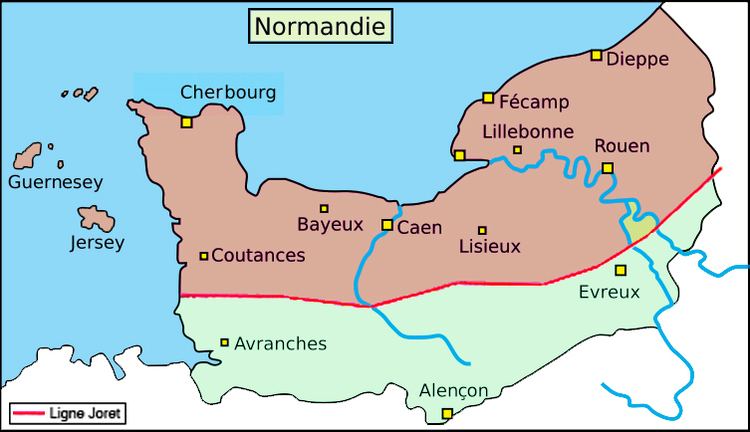 | ||
The Joret line (French ligne Joret) is an isogloss used in the linguistics of the langues d'oïl. Dialects north of the line have preserved Vulgar Latin /k/ and /ɡ/ before /a/; dialects south of the line have palatalized /k/ and /ɡ/ before /a/. This palatalization gave Old French /tʃ/ and /dʒ/, then modern French /ʃ/ and /ʒ/. The line was first identified by Charles Joret and published in 1883.
Contents
To the north of the line lie the Picard language and some dialects of the Norman language. To the south and the east lie other Oïl dialects including southern Norman and French. The area north of the ligne Joret is sometimes called the Normano-Picard domain.
Geography
The Joret line extends from the Channel Islands (including Jèrriais, Guernésiais and Sercquiais) and across the continent from Granville, Manche to the linguistic border with the Dutch language in the North of France and Belgium. It passes through Normandy north of Granville and Villedieu-les-Poêles and divides Manche in two linguistically and separates Calvados and Orne along with Eure.
In Picardy, the line runs with the Amiénois and Thiérache, up to the west of Rebecq, Beaumont and Chimay in Belgium.
Examples
Second isogloss
Another effect of the palatalizations a bit further to the north but quite parallel was this:
Third isogloss
A third isogloss, marking a consonantal change unrelated to the others, more or less follows the Joret line throughout Normandy and continues through northeastern France. It includes all of Picardy, Wallonia, Champagne, Lorraine and a part of Burgundy.
Germanic /w/ (sometimes Latin /v/ was affected as well) was kept north of the line (written w or v), but became /g/ (written g or gu) south of the line.
Toponymy
The Joret line affects toponyms in Normandy and Picardy ; for example : Cambrai (corresponding to Chambray), Camembert, Carentan (corresponding to Charenton), Caen (Wace gallicized as Chaem).
Norman place-names derived from the Gallo-Romance word Campaniacum show initial C- in some cases (Campigny, north) and initial Ch- in others (Champigny-la-Futelaye, south).
